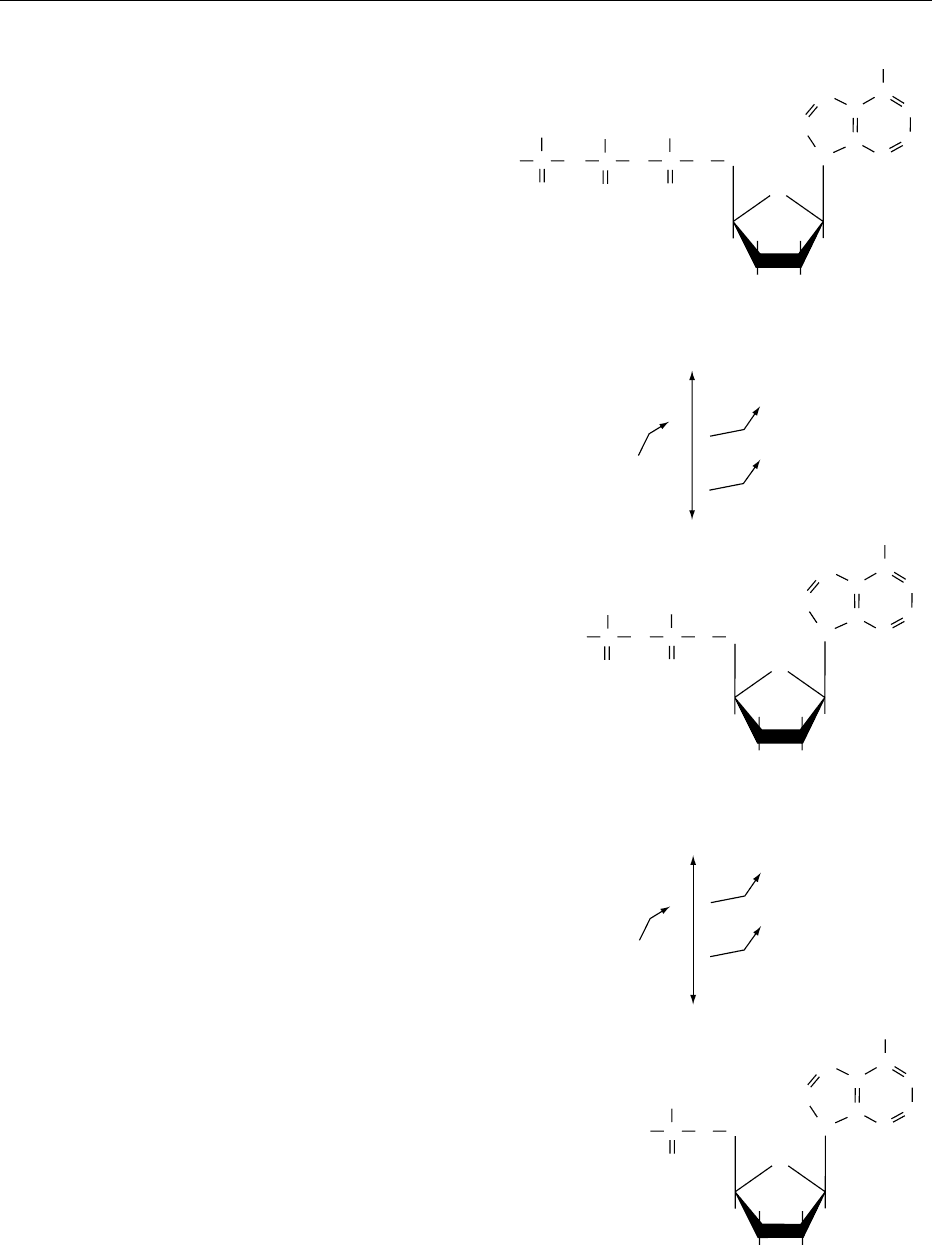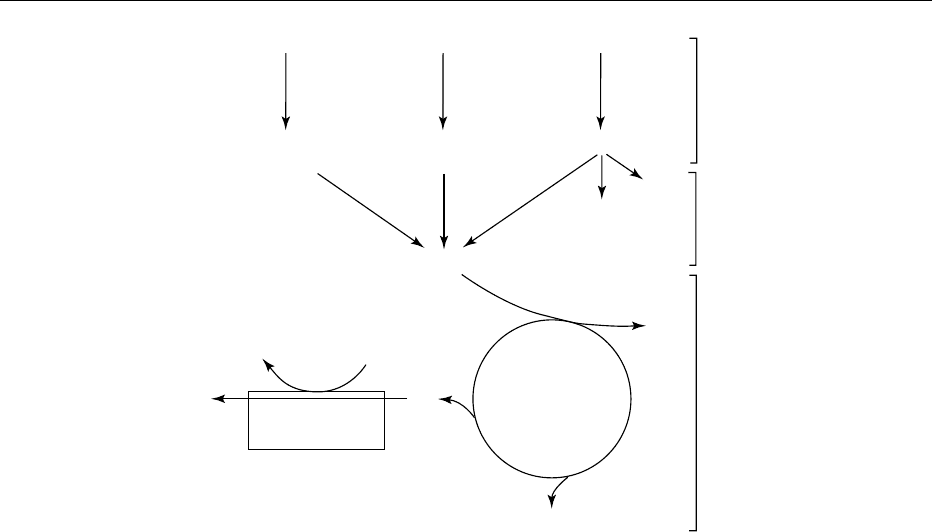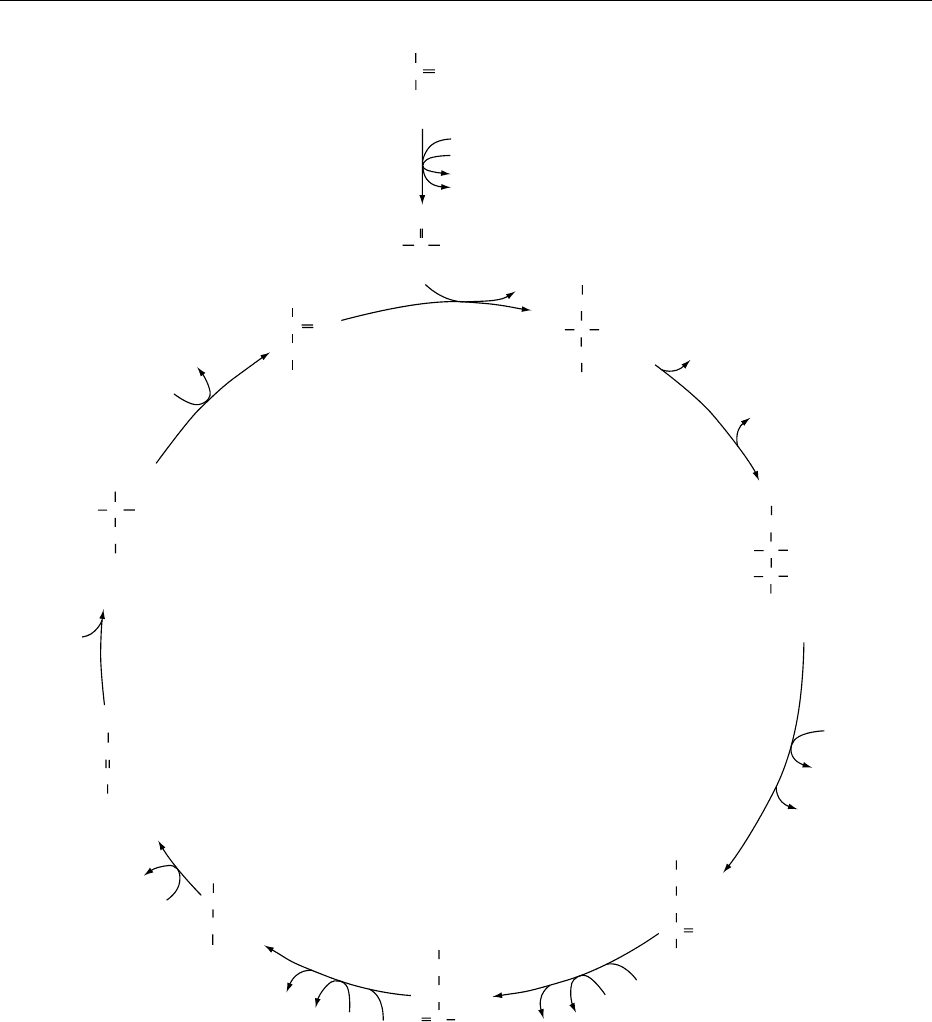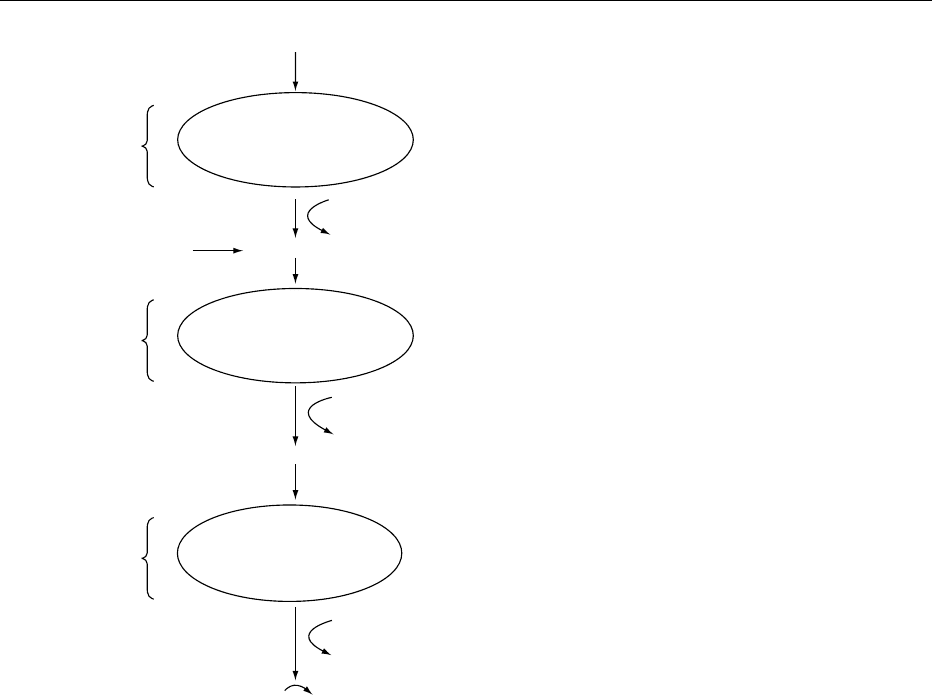Caballero B. (ed.) Encyclopaedia of Food Science, Food Technology and Nutrition. Ten-Volume Set
Подождите немного. Документ загружается.


regulation of energy expenditure to maintain energy
balance. In this case, energy expenditure rises when
intakes are high and would otherwise lead to an
increase in energy stores, and decreases when intakes
are low and stores need to be conserved or used
efficiently. A consistent effect of high energy intakes
or low energy intakes is a change in body size. This
tends to buffer the effects of the inequality by altering
expenditure in the same direction as intake. However,
this is more of an obligatory response in energy ex-
penditure and less the facultative or adaptive re-
sponse, mentioned earlier. The main mechanism of
inefficient energy disposal in overeating has been sug-
gested to be uncoupled oxidative phosphorylation in
brown adipose tissue. The most recent suggestion is
that the role of the facultative response in the regula-
tion of energy balance may be secondary to its func-
tion in regulating the supply of essential nutrients in
nutrient-deficient or unbalanced diets.
0020 In undernutrition and during slimming the activity
of the sympathetic nervous system, essential for
brown adipose tissue thermogenesis, and protein syn-
thesis – an energetically expensive process – may be
reduced. However, in humans, by far the majority of
the savings in energy expenditure with undernutrition
occur owing to the smaller body size and reduced
volitional physical activity. The effect of reductions
of the metabolic rate of cells is less than 15% of the
total reduction. Similarly, the magnitude of DIT of
overfeeding at the rates seen in our societies and with
our diets is almost certainly low and unlikely to
exceed 10% of the extra energy ingested.
0021 A multitude of tertiary-level factors – behavioral,
social, and psychological – influence intake and
expenditure and, ultimately, energy balance. These
include the lifestyle factors referred to earlier, labor-
saving devices, availability of private transport,
shorter working hours, and inactive leisure. At the
same time, the constant availability of food, its var-
iety, and increased palatability and acceptance may
easily override control mechanisms evolved for other
diet types and nutritional circumstances. Median
weights and weights for height or age are increasing
in both Europe and North America, illustrating the
increased incidence of positive energy balance. Re-
duced physical activity and increased sedentary be-
haviors, such as watching television, contribute to
lower energy expenditure and are widely regarded
as having a role in the increased prevalence of over-
weight and obesity, but exactly what, it is difficult to
uncover. Longitudinal studies in the UK do not con-
sistently show falls in physical activity over the last 10
years, particularly in nonmanual households. There
are several dimensions to physical activity, which
affect different segments of the population differently.
0022It has been suggested that to avoid obesity popula-
tions should be physically active throughout life at a
PAL of 1.7–1.8. As present levels in adults may be
nearer 1.55, this would involve the adoption of
20 min vigorous activity per day, such as running or
team ball games, or 60 min per day of moderate
activity such as brisk walking or cycling. These are
clearly difficult to fit into most people’s daily lives and
a more appropriate strategy would be to perform
everyday activities in a more energy-expensive
manner, to walk instead of using fuelled transport,
to do activities standing instead of sitting, etc. Re-
cently, it has been suggested that fidgeting may play a
more important role in energy expenditure than was
previously thought. Training studies of the over-
weight but not obese suggest that increased physical
activity plus dieting is associated with weight loss of
only some 3 kg over 6 months. Women tend to be less
successful than men in reducing body weight and
fatness through exercise. It is not known if these
differences have physiological or behavioral origins.
0023One tenet of health and fitness is that body weight
should not increase in the adult years. However, data
from cross-sectional studies of 7000 male runners,
young and old, suggest that in modern society to
achieve this requires increasing physical activity
with age. Age-neutral body mass index (body weight
allowing for height) is not compatible with age-
neutral physical activity. Running distances needed
to increase 2 km week
1
for each increase of 1 year
of age. Again, such increases are not easy to adopt
and against the trend in the majority of even ardent
runners and joggers.
0024One objection to physical activity as a means of
achieving a more favorable energy balance that has
been raised is that physical activity and increased
energy expenditure cause energy intake to increase
with no net effect on energy balance and body weight.
The evidence suggests there often is compensation in
energy intake but not beyond the amount of energy
expended in exercise.
0025Although weight gain with age is commonplace, the
increment in body energy represents only a tiny pro-
portion of the energy throughput. Looked at in this
way, regulation and control are still quite accurate.
See also: Body Composition; Exercise: Metabolic
Requirements; Metabolic Rate
Further Reading
Ainsworth BE, Haskell WL, Leon AS et al. (1993) Compen-
dium of physical activities: classification of energy costs
of human physical activities. Medicine and Science in
Sports and Exercise 25: 71–80.
ENERGY/Energy Expenditure and Energy Balance 2107

Blaxter K (1989) Energy Metabolism in Animals and Man.
Cambridge: Cambridge University Press.
Blaxter K and Waterlow JC (1985) Nutritional Adaptation
in Man. London: John Libbey.
Bouchard C, Despres J-P and Tremblay A (1991) Genetics
of obesity and human energy metabolism. Proceedings
of the Nutrition Society 50: 139–147.
Department of Health (1991) Dietary Reference Values for
Food Energy and Nutrients for the United Kingdom.
Report on Health and Social Subjects, 41. London:
HMSO.
Durnin JVGA and Passmore R (1967) Energy, Work and
Leisure. London: Heinemann.
Ferro-Luzzi A and Martino L (1996) Obesity and physical
activity. In: Chadwick DJ and Cardew G (eds) The
Origins and Consequences of Obesity, pp. 207–266.
Chichester: Wiley.
Fox K (1999) Aetiology of obesity X: physical inactivity. In:
Obesity: Report of the British Nutrition Foundation
Task Force, pp. 116–132.Oxford: Blackwell Science.
Garrow JS (1974) Energy Balance and Obesity in Man.
Amsterdam: North-Holland.
McArdle WD, Katch FI and Katch VL (1996) Exercise
Physiology: Energy, Nutrition and Human Perform-
ance. Baltimore, MD: Williams & Wilkins.
Norgan NG and Ferro-Luzzi A (1996) Human adaptation
to energy undernutrition. In: Fregly MJ and Blatteis CM
(eds) Handbook of Physiology Section 4 Environmental
Physiology, pp. 1391–1409. New York: Oxford Univer-
sity Press.
Shetty PS (1999) Adaptation to low energy intakes: the
responses and limits to low intakes in infants, children
and adults. European Journal of Clinical Nutrition
53(suppl. 1): S14–S33.
Stock MJ (1999) Gluttony and thermogenesis revisited.
International Journal of Obesity 23: 1105–1117.
van Raaij J (1998) Energy. In: Mann J and Truswell SS (eds)
Essentials of Human Nutrition, pp. 73–90. Oxford:
Oxford Medical Publications.
Williams PT (1997) Evidence for the incompatibility of age-
neutral overweight and age-neutral physical activity
standards from runners. American Journal of Clinical
Nutrition 65: 1391–1396.
World Health Organization (1985) Energy and Protein
Requirements. Report of a Joint FAO/WHO/UNU
Expert Consultation. Geneva: World Health Organiza-
tion.
Energy Expenditure See Metabolic Rate
ENERGY METABOLISM
S Rubinstein-Litwak, Clarksville, MD, USA
Copyright 2003, Elsevier Science Ltd. All Rights Reserved.
Introduction
0001 All living organisms need energy to perform the most
basic of natural functions, that is, they need energy to
survive. Humans consume energy from the moment
they are conceived to the moment they cease to exist,
and considering that, according to the First Law of
Thermodynamics, ‘energy is not created or destroyed,
just transformed,’ where do humans obtain this much
needed energy? The answer to this question lies
within each cell of each individual organism.
0002 The group of chemical and biological reactions
involved in the process of obtaining and spending
energy is known as energy metabolism. There are
two major sources of free energy: food oxidation
and light absorption.
0003The input of energy needs to be constant and must
be converted into a highly accessible form to be used
for three major purposes:
.
0004performance of mechanical work in muscle con-
traction and other cellular movements;
.
0005active transport of molecules and ions;
.
0006synthesis of biomolecules that originate from
simple precursors, including macromolecules.
Metabolism
0007Metabolism is defined as the series of physicochem-
ical reactions that take place in cells with the purpose
of synthesizing, converting, utilizing, and cataboliz-
ing substrates. The primary goal of metabolism is to
form adenosine triphosphate (ATP), nicotinamide
adenine dinucleotide (NADH) and building blocks
for biosynthesis (i.e., amino acids, fatty acids, and
sugars). It is through this constant generation and
2108 ENERGY METABOLISM

consumption of metabolic substrates (i.e., ATP,
NADH,) that living organisms transform free energy
into channeled energy. Metabolism includes catabolic
and anabolic pathways that are almost always distinct.
During anabolic or degradative pathways, ATP is util-
ized, whereas during catabolic or biosynthetic path-
ways, ATP is generated. Most reactions of the human
metabolism are performed in the presence of enzymes,
which are protein molecules highly adapted and regu-
lated that catalyze said reactions. Many reactions also
require cofactors or coenzymes, most commonly vita-
min molecules. The amount of enzymes, the catalytic
activity of the enzymes, and the accessibility of sub-
strates present at the time of the reactions regulate the
metabolic process. The energy charge, defined as the
energy status of the cell based on the relative amounts
of ATP, adenosine diphosphate (ADP), and adenosine
monophosphate (AMP), plays a central role in meta-
bolic regulations. A low energy charge stimulates ATP-
generating pathways, while inhibiting ATP-utilizing
pathways. ATP is the only form of energy that can be
used directly by the cells; energy released as heat is lost
and cannot be utilized.
ATP–ADP Cycle
0008 The ATP–ADP cycle is the basis for energy exchange
in biological systems. ATP acts as the principal donor
of energy and has a very high turnover. When energy
is needed, ATP is hydrolyzed to ADP and ortho-
phosphate (Pi). If more energy is needed, ADP can
be further hydrolyzed to AMP and pyrophosphate
(PPi). ATP can also be regenerated from ADP during
oxidation of fuel molecules or when light is trapped
(i.e., photosynthesis) (Figure 1).
Metabolism of Food Molecules
0009 The energy in food becomes available only after the
macromolecules contained in it (carbohydrates, fat,
or protein) are transformed into less complex struc-
tures by undergoing a series of reactions. After adjust-
ment for net absorption and urinary losses, the energy
value of these substrates is estimated as 4 kcal g
1
for
carbohydrates, 4 kcal g
1
for proteins and 9 kcal g
1
for fat (16.8 kJ g
1
, 16.8 kJ g
1
, and 37.8 kJ g
1
,
respectively). Three stages in the generation of energy
from food oxidation have been described (Figure 2).
.
0010 Stage 1: Large molecules in food are broken down
into smaller units. No useful energy is generated in
this step.
.
0011 Proteins ! Amino acids
.
0012 Polysaccharides ! Simple sugars (i.e., glucose)
.
0013 Fats ! Glycerol þ fatty acids
.
0014 Stage 2: The recently formed smaller units are de-
graded once again, to yield a few simple units that
NH
2
C
C
C
N
N
NN
HC
CH
O
−
O
−
O
−
O
−
O
OO
O
O
O
P
P
P
H
H
OHOH
H
N
O
CH
2
NH
2
C
C
C
N
N
NN
HC
CH
O
−
O
−
O O
O
O
O
P
P
H
H
OHOH
H
N
O
CH
2
NH
2
C
C
C
N
N
NN
HC
CH
O
−
O
O
O
P
H
H
OHOH
H
N
O
CH
2
H
+
Pi
H
2
O
H
+
Pi
H
2
O
(b)
(a)
(c)
fig0001Figure 1 ATP metabolic path. (a) Adenosine triphosphate
(ATP); (b) adenosine diphosphate (ADP); (c) adenosine mono-
phosphate (AMP).
ENERGY METABOLISM 2109

play a central role in metabolism. Most molecules
are converted into acetyl coenzyme A (acetyl CoA).
During this step, some ATP is generated.
.
0015 Stage 3: During this step, 90% of the ATP is gener-
ated. It includes the citric acid cycle and oxidative
phosphorylation.
Carbohydrates
0016 Carbohydrates serve as energy stores, fuels, and
metabolic intermediates. When ATP is needed, poly-
saccharides can be rapidly mobilized to yield glucose,
which acts as a prime fuel for the generation of ATP.
Phosphorylated sugars are greatly involved in energy
production by acting as intermediate substrates in the
metabolic pathways. Glucose is the major form of
carbohydrate substrate andthepreferred energysource
for the brain, the renal cortex, and red blood cells.
0017 -Glycolysis Glycolysis includes a series of reactions
that convert glucose into pyruvate with a small pro-
duction of ATP. Reactions occur in the cytosol of the
cell. It represents the initial steps that lead to the
tricarboxylic acid cycle and the electron transport
chain. The glycolytic pathway has a dual role. On
one side, it degrades glucose to generate ATP, and on
the other, it provides building blocks for the synthesis
of cellular components. Glycolysis can be divided into
three stages that are presented in Figure 3.
.
0018 In the first stage, the substrate is trapped in the cell
to form a compound that can be readily cleaved
into phosphorylated three-carbon units from where
ATP is subsequently extracted. This consists of two
phosphorylations and one isomeration to convert
glucose into fructose 1,6-bisphosphate. In this step,
no energy is extracted, and two molecules of ATP
are used.
.
0019Glucose enters the cell through specific transport
proteins. Once in the cell, it is phosphorylated by
ATP to form glucose 6-phosphate.
.
0020Glucose 6-phosphate is isomerated into fructose
6-phosphate
.
0021Fructose 6-phosphate is phosphorylated by ATP,
forming fructose 1,6-bisphosphate.
.
0022In the second stage, some energy is generated. This
involves the conversion of fructose 1,6-bispho-
sphate into 3-phosphoglycerate and a molecule of
ATP.
.
0023Fructose 1,6-bisphosphate is split into glyceral-
dehyde 3-phosphate (which can be used in the
direct pathway) and dihydroxyacetone phos-
phate. With the help of an isomerase enzyme,
triose phosphate isomerase, the molecule of
dihydroxyacetone phosphate can be converted
into a second molecule of glyceraldehyde. The
result is the formation of two molecules of glycer-
aldehyde 3-phosphate from one molecule of fruc-
tose 1,6-bisphosphate.
.
0024Glyceraldehyde 3-phosphate is converted into
1,3-bisphosphoglycerate (1,3-BPG), whichis com-
bined with ADP to generate 3-phoshoglycerate
FATS
POLYSACCHARIDES PROTEINS
Amino acids
Glucose and
other sugars
Fatty acids and
glycerol
Acetyl CoA
CoA
Citric
acid
cycle
2 CO
2
e
−
ADPATP
Oxidative
phosphorylation
O
2
Stage
III
Stage
II
Stage
I
fig0002 Figure 2 Stages in the extraction of energy from food. From Stryer L (1995) Biochemistry, 4th edn. New York: W.H. Freeman, with
permission.
2110 ENERGY METABOLISM

plus ATP. This step represents the first ATP gen-
erating reaction in glycolisis.
.
0025 In the last stage, 3-phosphoglycerate is converted
into pyruvate, and a second molecule of ATP is
formed.
.
0026 The phosphoryl group in 3-phosphoglycerate is
rearranged to form 2-phosphoglycerate.
.
0027 2-Phosphoglycerate is dehydrated to form phos-
phoenolpyruvate.
.
0028 Phosphoenolpyruvate is converted into pyruvate.
During this reaction, the phosphoryl group is trans-
ferred to ADP to form a molecule of ATP.
The net reaction in the transformation of glucose into
pyruvate is:
Glucose þ 2Piþ2 ADP þ 2 NAD
þ
!
2 pyruvate þ 2 ATP þ2 NADH þ 2H
þ
þ 2H
2
O:
Fat
0029 Dietary fat is primarily distributed as triacylglycer-
ols, which are highly concentrated stores of meta-
bolic energy. To be able to use fat as energy,
triacylglycerols need to be broken down to fatty
acids and glycerol. This is achieved by hydrolysis
with the help of a lipase, an enzyme that aids in the
degradation of fat molecules. Oxidation of fatty
acids takes place in mitochondria. Before entering
the mitochondrial membrane, long-chain fatty acids
in the outer membrane need to bind to coenzyme A
to form acyl CoA. The activated fatty acids are
carried across the inner membrane with the help of
carnitine. Once in the mitochondria, Acyl CoA goes
through a four-step process, called b-oxidation. First,
acyl CoA goes through oxidation by flavin adenosine
dinucleotide (FAD), then through a hydration, a
second oxidation by nicotinamide adenine dinucleo-
tide (NAD), and finally a thiolysis by CoA. The result
is the reduction of the carbon chain of the fatty acid
by two carbon atoms and the formation of acetyl
CoA, NADH and FADH
2
. Acetyl CoA then enters
the tricarboxylic acid cycle by binding to oxaloace-
tate, while FADH
2
and NADH transfer their elec-
trons to molecular oxygen by means of the electron
transport chain.
0030 The glycerol moiety that was liberated in the
degradation of triacylglycerols can also be further
metabolized by entering the glycolitic pathway
as a three-carbon compound yielding eventually
pyruvate.
Proteins
0031 Proteins need to be degraded to amino acids so the
body can use them. Most of the amino acids are used
for the synthesis of new proteins, while the remaining
amino acids are used for metabolic fuel. Amino
acids can be used as the precursors for the synthesis
of glucose, ketone bodies, and fatty acids. After the
amino group is removed and converted to urea, the
carbon chain of ketogenic amino acids is degraded
to acetyl CoA or acetoacetyl CoA, to form ketone
bodies. At the same time, glucogenic amino acids
are degraded to pyruvate or one of the intermedi-
ates of the TCA cycle; a-ketoglutarate, succinyl
CoA, fumarate, or oxaloacetate to synthesize
glucose.
Glucose
ATP
ADP
ATP
ADP
Herokinase
Glucose 6-phosphate
Phosphoglucose
isomerase
Fructose 6-phosphate
Phosphofructose-
kinase
Fructose 1,6-bisphosphate
Aldolase
Triose phosphate
isomerase
Dihydroxyacetone
phosphate
Glyceraldehyde
3-phosphate
Glyceraldehyde
3-phosphate
dehydrogenase
NAD
−
+ Pi
NADH + H
−
1,3-Bisphosphoglycerate
ADP
ATP
Phosphoglycerate
kinase
3-Phosphoglycerate
2-Phosphoglycerate
Phosphoenolpyruvate
Phosphoglycerate
mutase
Enolase
H
2
O
Pyruvate
kinase
ADP
ATP
Pyruvate
fig0003Figure 3 Glycolysis. From Stryer L (1995) Biochemistry, 4th
edn. New York: W.H. Freeman, with permission.
ENERGY METABOLISM 2111

Tricarboxylic Acid Cycle
0032 The tricarboxylic acid (TCA) cycle is also known as
the citric acid cycle or the Krebs cycle. It constitutes a
series of reactions that involve the decarboxylation of
pyruvate to form acetyl CoA, which in turn is fully
oxidized to carbon dioxide (CO
2
) and water (H
2
O).
These reactions take place in the mitochondria. The
TCA cycle represents the final common pathway for
the oxidation of fuel molecules.
0033 The link between glycolysis and the TCA cycle is
the oxidative decarboxylation of pyruvate to form
acetyl CoA. Coenzyme A is a heat-stable cofactor
that plays a central role within the molecule in
metabolism. It can deliver activated acyl groups for
degradation and energy generation as well as for
biosynthetic purposes.
Pyruvate þ CoA þ NAD
þ
! Acetyl CoA þ CO
2
þ NADH:
The TCA cycle is graphically represented in Figure 4.
The start of the cycle includes the union of oxalo-
acetate (a four-carbon unit) with the acetyl group of
acetyl CoA (a two-carbon unit) to form citrate and
CoA. Citrate is then isomerized into isocitrate, which
undergoes the first oxidative decarboxylation of
the cycle to become oxalosuccinate and then a-
ketoglutarate. There then follows a second oxidative
decarboxylation that yields a molecule of succinyl
CoA. Succinyl CoA becomes attached to guanosine
diphosphate (GDP), resulting in the formation of suc-
cinate, guanosine triphosphate (GTP) and CoA. This
is the only step in the cycle that directly yields a high-
energy phosphate bond.
0034 Succinate is oxidized to fumarate, which in turn is
hydrated to form malate. The final step in the cycle is
the regeneration of oxaloacetate from malate. The
electrons that are released during the cycle are
transferred to NAD
þ
and FAD to be transported in
oxidative phosphorylation.
0035 The net reaction of the TCA cycle is:
Acetyl CoA þ 3 NAD
þ
þ FAD þ GDP þ Pi
þ 2H
2
O ! 2CO
2
þ 3 NADH þ FADH
2
þ GTP
þ 2H
þ
þ CoA
Oxidative Phosphorylation
0036 Oxidative phosphorylation is also known as the
electron transport chain. It includes the reactions
that result in the synthesis of ATP from ADP þ Pi.
Heat can also be generated when ATP production is
uncoupled from the respiratory chain.
Synthesis of ATP
0037Oxidative phosphorylation constitutes the major
source of ATP in aerobic organisms. During the oxi-
dation of fuel molecules, FADH
2
and NADH play a
central role as the major electron carriers taking the
electrons to the ultimate acceptor, oxygen (O
2
). The
transfer of electrons from NADH and FADH
2
to O
2
takes place in the inner membrane of the mitochon-
dria. During this transfer, a number of protons are
pumped out of the mitochondrial matrix, forming a
proton gradient. Finally, with the help of ATPase, an
ATP-synthesizing complex, the protons flow back
into the matrix generating the necessary energy to
generate ATP.
0038The electrons are transferred from NADH to O
2
through a chain of three large protein complexes.
Each complex is an electron-driven proton pump
that contains multiple oxidation–reduction centers.
The electron carrying groups that take the electrons
from NADH and FADH
2
to O
2
are flavins, iron–
sulfur clusters, hemes and copper ions (Figure 5).
0039Complex I, also known as NADH-Q reductase,
involves the first process through which the electrons
from NADH are transferred. NADH binds to a flavo-
protein, flavin mononucleotide (FMN), transferring
its two high potential electrons and losing its
hydrogen molecules. The result is FMNH
2
and
NAD
þ
. From there, the electrons are transferred to
coenzyme Q, also known as ubiquinone Q, on their
way to complex III. Coenzyme Q is also the entry
point for the electrons of FADH
2
to the chain. While
some energy is lost as heat, ATP is also formed in a
coupled reaction by bonding ADP þ Pi. Complex III,
also known as cytochrome reductase or cytochrome
b, is the second proton pump in the electron transport
chain. In this step, the electrons from coenzyme Q are
transferred to cytochrome b and then to cytochrome
c, a water-soluble protein, on their way to complex
IV. During the transfer, some protons are once again
pumped out of the mitochondrial membrane. A
second coupled reaction results in the formation of
ATP. Complex IV, also known as cytochrome oxidase
or cytochrome a, plays a role in the transfer of the
electrons from cytochrome c to O
2
. In the final step,
the electrons bind to O
2
to form H
2
O.
0040The net reaction from each glucose molecule that
enters glycolysis and proceeds through the TCA cycle
and oxidative phosphorylation is:
2112 ENERGY METABOLISM

Glucose þ 6O
2
þ 36 ADP þ 36 Pi ! 6CO
2
þ 36 ATP þ 6H
2
O:
Generation of Heat
0041 When there is not enough energy to transform
ADP into ATP, mitochondrial electron transport is
uncoupled from ATP synthesis by a proton leak. The
result is the release of energy as heat. Uncoupling
proteins (UCP) are known to be responsible for
the leak that sometimes occurs during oxidative
phosphorylation. Three uncoupling proteins have
been identified. Thermogenin or UCP1 present in
brown adipose tissue, UCP2 present in several tissues,
and UCP3 mainly present in skeletal muscle. UCP
COOH
C
O
Pyruvate
O
CoA
NAD
+
NADH + H
+
CO
2
CH
3
TPP
C
(CoA)
H
3
C
Acetyl CoA
CoA
COOH
COOH
COOH
COOH
CH
2
CH
2
COOH
CH
2
H
2
O
H
2
O
C
C
COOH
COOH
COOH
CH
2
OH
C
C
HO
COOH
COOH
CH
2
CH
2
O
C
COOH
CH
2
CH
2
COOH
COOH
CH
2
CH
2
COOH
COOH
CH
CH
COOH
COOH
CH
2
H
H
ISOCITRATE
NAD
+
NAD
+
NADH+H
+
NADH+H
+
CO
2
CO
2
ALPHA-
KETOGLUTARATE
C
O
(CoA)
CoA
CoA
SUCCINATE
GTP
GDP
+
P
H
2
O
FADH
2
FAD
FUMARATE
H
2
O
MALATE
C
OHH
NADH + H
+
NAD
+
O
OXALOACETATE CITRATE
SUCCINYL CoA
fig0004 Figure 4 Tricarboxylic acid cycle.
ENERGY METABOLISM 2113

play a role in energy metabolism by limiting the syn-
thesis of ATP and dissipating energy as heat, thus
reducing the efficiency of energy production.
Summary
0042 As described in the previous paragraphs, humans
obtain their energy from food. Once in the body, the
macromolecules found in food undergo a series of
degenerative reactions that yield the necessary sub-
strates to promote the continuation of a process
known as energy metabolism. The result of this very
precise series of chemical and biological reactions is
the transformation of energy in its free form into
energy that can be fully utilized by the human body.
Carbohydrates are degraded to simple sugars, fat to
fatty acids and proteins to amino acids. Eventually,
the complete oxidation of these molecules yields
acetyl CoA, which acts as a link to the TCA cycle.
0043In the TCA cycle, acetyl CoA is fully oxidized to
CO
2
and H
2
O. Throughout the cycle, hydrogen
atoms and their electrons are released. The hydrogen
atoms are then bound to other compounds, resulting
in the production of three molecules of NADH, one
FADH
2
, and one GTP. These new molecules contain
the energy originally found in acetyl CoA. For the
production of ATP, NADH and FADH
2
carry the
electrons from the TCA cycle through an electron
transport chain known as oxidative phosphorylation.
The process ends with the production of ATP and
H
2
O. An alteration in oxidative phosphorylation
can impair the production of ATP and dissipate
energy as heat instead. Uncoupling proteins are
responsible for this.
See also: Amino Acids: Metabolism; Carbohydrates:
Digestion, Absorption, and Metabolism; Metabolism of
Sugars; Fatty Acids: Metabolism; Tricarboxylic Acid
Cycle
Further Reading
Lehninger AL (1975) Biochemistry, 2nd edn. New York:
Worth Publishers.
Linder MC (1991) Nutritional Biochemistry and Metabol-
ism. New York: Appleton & Lange.
Ricquier D and Bouillaud F (2000) The uncoupling protein
homologues: UCP1, UCP2, UCP3, StUCP and AtUCP.
Biochemistry Journal 345: 161–179.
Rubinstein S (1998) Energy metabolism. In: Sadler MJ
Strain JJ and Caballero B (eds) Encyclopedia of Human
Nutrition. pp. 682–687. London: Academic Press.
Schrauwen P, Walder K and Ravussin E (1999) Human
uncoupling proteins and obesity. Obesity Research
7(1): 97–105.
Stryer L (1995) Metabolic energy: generation and storage.
In: Biochemistry, 4th edn, pp. 443–652. New York: WH
Freeman and Company.
NADH-Q reductase
Flavoprotein
ADP + Pi
ATP
ADP + Pi
ATP
ADP + Pi
ATP
Coenzyme Q
COMPLEX I
COMPLEX III
COMPLEX IV
FADH
2
Cytochrome reductase
Cytochrome b
Cytochrome oxidase
Cytochrome a
Cytochrome c
2H + O H
2
O
NADH
fig0005 Figure 5 Oxidative phosphorylation.
2114 ENERGY METABOLISM

ENTERAL NUTRITION
V A Stallings, The Children’s Hospital of Philadelphia,
Philadelphia, PA, USA
Copyright 2003, Elsevier Science Ltd. All Rights Reserved.
Enteral Feeding
0001 The nutritional status of hospitalized patients has
received much interest since studies in the 1970s
and 1980s indicated that up to 50% of surgical and
medical pediatric and adult patients have some
clinical or biochemical evidence of malnutrition.
(See Protein: Deficiency.)
0002 The four main groups of patients who generally
require nutrition support are:
1.
0003 Patients with existing moderate-to-severe malnu-
trition indicated by weight loss in excess of 10%,
muscle wasting, peripheral edema and/or albumin
less than 30 g l
1
.
2.
0004 Patients with mild-to-moderate malnutrition who
are at-risk of becoming further nutritionally com-
promised as a result of their medical condition.
3.
0005 Patients with a normal nutritional status but who,
as a result of their medical condition, would not
be able to commence normal feeding of adequate
nutrient intake for a length of time appropriate for
age and disease status, thereby potentially leading
to a state of malnutrition.
4.
0006 Pediatric patients who are unable to maintain a
normal pattern of growth and development, or
who require nutrition support to promote an
increased rate of growth (catch-up growth).
In order to prevent and treat malnutrition, the early
identification of the ‘at-risk’ patient is very important.
(See Malnutrition: The Problem of Malnutrition.)
Providing Enteral Nutrition Support
Oral Feeding
0007 Patients who cannot safely consume solid food may
take blenderized food. Patients who are able to take
some amount of food but cannot maintain an ad-
equate nutritional status may require oral dietary sup-
plements. There are two main types of dietary
supplements:
1.
0008 Modular, i.e., single nutrient supplements such as
protein, fat, carbohydrates, vitamins, or minerals.
There are several formulations of each type of nu-
trient. For example, protein may be provided as
intact proteins, protein hydrolysates, or individual
amino acids, and fats as long-chain fats, including
essential fatty acids and medium-chain trigly-
cerides.
2.
0009Complete, i.e., balanced nutrient supplements
which contain all the nutrients and may be taken
as the whole meal, part of a meal, or a snack.
There are a vast number of liquid and semisolid com-
mercial nutritional products that may be used for
enteral feeding. These products may be designed for
a specific age group (i.e., infant, adult) or specific
medical condition (i.e., premature infant, pulmonary
failure, renal failure).
Enteral Tube Feeding
0010Enteral tube feeding is the preferred route of diet
administration for all patients with a functioning
gastrointestinal tract who, for a variety of reasons,
do not take adequate nutrition from food and/or oral
dietary supplements. In recent years, research and
clinical experience has led to many technical advances
in the formulation and presentation of enteral formu-
las and feeding equipment. As a result, technology-
assisted enteral support is now widely used. The most
commonly used routes for providing enteral nutrition
are via nasogastric and gastrostomy feeding tubes.
0011-Nasogastric feeding Fine-bore feeding tubes are the
tubes of choice as they are narrow, softer, flexible,
and more comfortable for the patient than the previ-
ously used large-bore nasogastric tubes. The use of
fine-bore feeding tubes has reduced many of the
common nasal tube complications such as rhinitis,
esophagitis, pharyngitis, esophageal strictures, and
erosions.
0012Fine-bore feeding tubes are inserted per nasally
with a wire stylet to facilitate passage. The correct
position of the tube may be confirmed by aspiration
of the gastric contents and testing for acidic pH, or
by auscultation of the epigastrium as air is injected
into the stomach via the feeding tube. Radiological
confirmation of the correct position of the nasogas-
tric tube is required in patients who have an impaired
gag reflex, those who are semiconscious or un-
conscious, and other high-risk patients including
infants.
0013Nasogastric feeding may not be suitable for
patients who are at-risk of regurgitation and/or pul-
monary aspiration of the feed, and nasoduodenal or
nasojejunal feeding tubes should be considered for
these patients. Enteral feeding tubes with small
weighted tips (3–5 g) are available to facilitate tube
passage postpylorically for feeding directly into the
ENTERAL NUTRITION 2115

duodenum or the jejunum. Figure 1 shows weighted
fine-bore nasoenteral tubes (Corpak Medsystems,
USA) and two types of unweighted nasogastric feed-
ing tubes. In some patients, endoscopic placement of
the feeding tube may be undertaken to ensure rapid
and correct placement.
0014 -Gastrostomy feeding Patients who require long-
term or permanent enteral feeding should be con-
sidered for gastrostomy feeding tube or gastrostomy
button (a smaller appliance which is almost flush with
the skin) placement. The technique of percutaneous
endoscopic gastrostomy (PEG) is a well-established
procedure for providing enteral nutrition support.
Although the feeding gastrostomy may be placed sur-
gically, PEGs compare favorably, with a lower mor-
bidity and cost; the surgical gastrostomy requires a
laparotomy and a general anesthetic, whereas the
PEG is performed under local anesthesia using a
fiber-optic endoscope. A range of PEG kits are avail-
able for infants, children, and adults. A feeding
jejunostomy may be considered as the means of
providing early postoperative nutrition support in
selected patients and may be used for short- or long-
term support.
Techniques of Administration of Enteral
Tube Feeding
0015 Enteral formulas are usually given from a reservoir
(plastic bag) via appropriate tubing to connect to the
feeding tube (nasogastric, gastrostomy, jejunostomy).
The formula is infused either by gravity or by mech-
anical peristaltic pump to ensure a selected and steady
delivery rate. The enteral feeding administration set
should be changed at least every 12 h to minimize the
risk of infectious complications. The method of con-
tinuous feeding by a pump saves nursing time and
ensures that the prescribed amount and rate of for-
mula are provided. Bolus feeding is considered more
physiological, but this method of enteral nutrition has
a greater incidence of side-effects, such as regurgita-
tion, distention, and diarrhea.
0016Intermittent enteral tube feeding during the day or
the administration of continuous overnight (8–12 h)
infusion can be of benefit to patients who may be able
to take small quantities of food. This is common
practice when patients are being transitioned for
total intravenous nutrition support for conditions
such as short-bowel syndrome.
Enteral Formulas Tube Feeding
0017In the past, regular hospital food was blenderized,
but these preparations were too viscous for most
feeding tubes. Further dilutions lowered the nutrient
density, and the resulting blended feed was often
nutritionally inadequate. The problems of ensuring
nutritional quality while avoiding microbial con-
tamination of these feeds, along with the time
taken for their preparation, has led to the increa-
sed use of commercially prepared ‘ready-to-feed’
enteral formulas in most hospital and home care
settings.
Types of Enteral Formulas
0018The four main groups of commercially available
enteral diets are polymeric, predigested, disease-
specific, and modular. The selection of the most ap-
propriate enteral formulas requires consideration of
the patient’s age, nutritional status, disease process,
and the specific nutritional requirements.
0019-Polymeric formulas Polymeric formulas are indi-
cated for the majority of patients with normal or
near-normal gastrointestinal function. The dietary
constituents in polymeric enteral formula generally
are as follows: energy – carbohydrate as glucose poly-
mers, fat as long-chain triglycerides; nitrogen – whole
protein; vitamins; minerals;andtrace elements.(See
Carbohydrates: Requirements and Dietary Import-
ance; Energy: Measurement of Food Energy; Fats:
Requirements; Minerals – Dietary Importance; Pro-
tein: Requirements; Vitamins: Overview.)
0020Most standard polymeric diets have an energy
density of 4.2 kJ (1 kcal) ml
1
and a nitrogen concen-
tration of 5–7gl
1
. Some patients may require the
energy and nitrogen-dense formulations which con-
tain 8–10 g of nitrogen per liter and possess an energy
density of 6.3 kJ (1.5 kcal) ml
1
or more. Polymeric
diets containing dietary fiber are available and may
promote the regulation of bowel function in some
enterally fed patients. The use of enteral formulas
containing fiber has been suggested in the elderly,
those who require long-term nutritional support,
and patients with neurological conditions and enteral
fig0001 Figure 1 Fine-bore nasoenteral tubes (courtesy of Corpak
Medsystems, USA).
2116 ENTERAL NUTRITION
